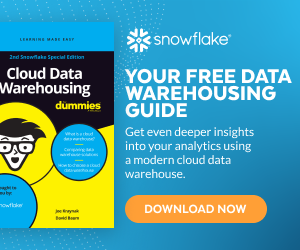What is an Enterprise Data Warehouse?
An enterprise data warehouse (EDW) is a relational data warehouse containing a company’s business data, including information about its customers. An EDW enables data analytics, which can inform actionable insights. Like all data warehouses, EDWs collect and aggregate data from multiple sources, acting as a repository for most or all organizational data to facilitate broad access and analysis.
Data Warehouse versus Enterprise Data Warehouse
The difference between an EDW and a data warehouse is semantic. An EDW is a data warehouse that encompasses and stores all of an organization’s data from sources across the entire business. A smaller data warehouse may be specific to a business department or line of business (like a data mart). In contrast, an EDW is intended to be a single repository for all of an organization’s data.
Key Components of an Enterprise Data Warehouse
A typical EDW consists of:
- Data Sources: These encompass data collected from various operational and transactional systems within the organization, such as Enterprise Resource Planning (ERP) systems, Customer Relationship Management (CRM) platforms, finance applications, Internet of Things (IoT) devices, and mobile and online systems.
- Staging Area: This serves as an intermediate space where data is aggregated, cleaned, and prepared before being loaded into the EDW. The staging area ensures that data is in a consistent and usable format, ready for further processing and analysis.
- Presentation or Access Space: This component provides an interface for users to access and interact with the data stored in the EDW. It enables analytics, querying, reporting, and data sharing, facilitating efficient decision-making and strategic insights across the organization.
- Data Tool Integrations or APIs: An EDW often integrates with a variety of data tools and software to enhance its functionality. These may include Business Intelligence (BI) software, data ingestion tools, ETL tools, and other APIs that enable seamless data integration and processing within the EDW.
By combining these components, an enterprise data warehouse offers a centralized and unified platform for data management and analysis, empowering organizations to harness the full potential of their data assets and make data-driven decisions.
What are the Benefits of an Enterprise Data Warehouse
An enterprise data warehouse (EDW) serves as a centralized repository for all of an organization's data, offering a host of valuable benefits. By consolidating diverse data sources, an EDW enhances data availability and accessibility, providing meaningful and contextual cross-organizational information. With faster access to crucial data, organizations can take faster-to-market actions, resulting in improved return-on-investment (ROI) and fostering accelerated company growth.
5 Business Needs that Require an Enterprise Data Warehouse
Nearly every department within a business can benefit from data-driven insights. Here are a few business needs that EDWs address.
1. Real-time access to data for action
EDWs make data viewable and actionable in real-time by favoring an extract-load-transform (ELT) approach over the once common extract-transform-load (ETL) paradigm, in which data was cleansed, transformed, or enriched on an external server prior to being loaded into the data warehouse. With an ELT approach, raw data is extracted from its source and loaded, relatively unchanged, into the data warehouse, making it much faster to access and analyze.
2. Holistic understanding of customer
EDWs enable a complete view of a business’s customer, helping improve campaign performance, minimize churn, and ultimately grow revenue. An EDW also facilitates predictive analytics, where teams use scenario modeling and data-driven forecasting to inform business and marketing decisions.
3. Tracking and ensuring data compliance
EDWs enable data customers to audit and vet data sources directly and find errors quickly. A modern EDW can also enable compliance with the EU’s General Data Protection Regulation (GDPR) without implementing an involved process to check multiple data locations.
4. Empowering users with limited technical knowledge
An EDW benefits non-technical employees in job functions beyond marketing, finance, and the supply chain. For example, architects and store designers can improve the customer experience within new stores by tapping into data from IoT devices placed in existing locations to understand which parts of the retail footprint are most or least engaging.
5. Consolidating data to a single, reliable repository
Modern data warehousing technology enables companies to store data across different regions and cloud providers. Users can query an EDW as though it were a global unified data set.
Snowflake and EDWs
Snowflake's platform offers a versatile enterprise data warehouse, adept at managing diverse data sets, from structured data to JSON. It includes Apache Iceberg table support, enriching its data warehousing and lakehouse capabilities. The Data Cloud integrates warehousing, data lakes, secure sharing, collaboration, and unifies analytical and transactional data. It emphasizes cybersecurity, data engineering, and science. The expanded Marketplace enables discovery and acquisition of data and services. Snowflake's scalable architecture efficiently meets fluctuating data demands across departments, business units, and clouds, maintaining flexibility and performance in complex data ecosystems.
See Snowflake’s capabilities for yourself. To give it a test drive, sign up for a free trial.
